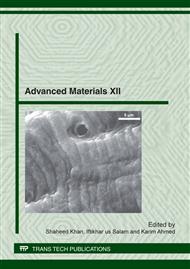[1]
G. Hussain, K. Sanaullah, Comparative parametric numerical simulations of materials used as liners in the explosively formed projectiles (EFPs). 1st International Conference on Advancements in Process Engineering (ICAPE-2008), Islamabad, Pakistan. (2008).
Google Scholar
[2]
K. Weimann, A. Blache, Explosively formed projectile with tantalum penetrator and armco iron stabilization base, 18th international symposium on ballistics, 15-19 November, San Antonio, 1999, p-603.
Google Scholar
[3]
K. Weimann, Producing Explosively Formed Projectiles, US Patent 535, 1987, p-949.
Google Scholar
[4]
V. Sharma, P. Kishore, S. Singh, An analytical approach for modeling EFP formation and estimation of confident effect on velocity, 16th international symposium on ballistics, 23-28 Sep. , San Francisco, CA, 1996. p- 585.
Google Scholar
[5]
W. Lanz, W. Odermatt, Penetration limits of conventional large caliber anti tank guns/ kinetic energy projectiles, 13th international symposium on ballistics, 1-3 June, Stockholm, 1992, p-225.
Google Scholar
[6]
T.W. Bjerke, G.F. Silsly, D.R. Scheffler, Yawed long rod armour penetration, int. journal of impact engineering, vol. 12, 1992, p- 281.
DOI: 10.1016/0734-743x(92)90473-7
Google Scholar
[7]
K. Weimann, Performance of Ta, Cu and Fe EFPs against steel targets, 15th international symposium on ballistics, v 2, 1995. P-399.
Google Scholar
[8]
F. Rondot, Performance of Ta EFP simulants, 17th international symposium on ballistics, v. 3, 1998. P-81.
Google Scholar
[9]
F. Rondot, Terminal ballistics of the EFPs-A numerical comparative study between hollow and solid simulants, 19th international symposium on ballistics, 7-11 May, Interlaken, 2001, p-455.
Google Scholar
[10]
Bo. Janzon, N. Burman, J. Forss, S. Karlsson, E. Liden, EFP modeling by numerical continuum dymanics on personal computers- A comparison between PC-Dyna2D, ZEUS and Autodyn-2D, 13th international symposium on ballistics, 1-3 June, Stockholm, 1992, p-457.
Google Scholar
[11]
F., Rondot, C. Berner, Performance of aerodynamically optimized EFP stimulants, 17th international symposium on ballistics, Midrand, South Africa, 1998, Vol. 3, p-225.
Google Scholar
[12]
S. Pappu, L.E. Murr, Hydrocode and micro-structural analysis of explosively formed penetrators, journal of material science, 37(2):, 2002, p-233.
Google Scholar


